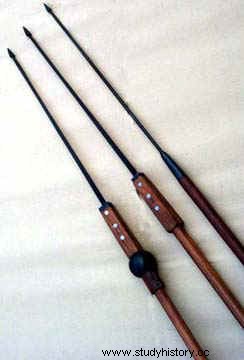Weapon par excellence of the Roman legionnaire modernized by Marius during his reform which replaced one of the metal pegs which hold the tip with a wooden peg so that it breaks on impact tt while remaining attached to the shaft making very difficult weapon to tear off from a shield eg.
immortalized in popular imagery by Asterix(webmaster comment)

Originally, this weapon was Samnite. It was normally composed of an iron at least twenty centimeters long, the hollow part of which received a wooden handle firmly fixed by two iron pegs. This fixing was then replaced by an iron dowel and another wooden one:during the impact in a shield, the latter broke freeing the pole which then hung towards the ground. The legionnaire could then put his foot on the pole, to force his enemy to uncover himself, by lowering his shield. If the pilum did not reach its goal, it broke anyway, preventing the Romans' enemies from picking it up on the ground to send it back to them.
The handling of the pilum was not described by ancient authors. Its mode of launch by legionnaires in close formation is difficult to imagine:a movement of impulse is necessary, either by swinging the arm and the bust, or by taking one or more steps of momentum. In both cases, this gesture is not feasible if the legionnaires are in close ranks one behind the other. Various maneuvers can be imagined (chaining forward, launch, retreat), all involving strong coordination, acquired through precise training.
It is understandable that the primipile centurion who commanded this maneuver had the highest rank among the centurions.
Julius Caesar in his Commentaries on the Gallic Wars described the effectiveness of the pilum in breaking the momentum of enemy charges, piercing the attackers' shields, or pinning them together if the opponents had adopted a formation in tortoise (book I, Battle against the Helvetians).
Each legionnaire usually wore two pilums (pila). Once the first planted in the shield of an opposing fighter, he was handicapped in his movements by the handle of the pilum, generally forcing him to continue the fight without protection.
At the end of the 3rd century, with the development of cavalry units and auxiliary units recruited from the barbarians and having their own armament, the use of the pilum became rare and then disappeared.
In Latin, the plural is pila, but in French the plural can be written pilums.
Originally, this weapon was Samnite. It was normally composed of an iron at least twenty centimeters long, the hollow part of which received a wooden handle firmly fixed by two iron pegs. This fixing was then replaced by an iron dowel and another wooden one:during the impact in a shield, the latter broke freeing the pole which then hung towards the ground. The legionnaire could then put his foot on the pole, to force his enemy to uncover himself, by lowering his shield. If the pilum did not reach its goal, it broke anyway, preventing the Romans' enemies from picking it up on the ground to send it back to them.
The handling of the pilum was not described by ancient authors. Its mode of launch by legionnaires in close formation is difficult to imagine:a movement of impulse is necessary, either by swinging the arm and the bust, or by taking one or more steps of momentum. In both cases, this gesture is not feasible if the legionnaires are in close ranks one behind the other. Various maneuvers can be imagined (chaining forward, launch, retreat), all involving strong coordination, acquired through precise training.
It is understandable that the primipile centurion who commanded this maneuver had the highest rank among the centurions.
Julius Caesar in his Commentaries on the Gallic Wars described the effectiveness of the pilum in breaking the momentum of enemy charges, piercing the attackers' shields, or pinning them together if the opponents had adopted a formation in tortoise (book I, Battle against the Helvetians).
Each legionnaire usually wore two pilums (pila). Once the first planted in the shield of an opposing fighter, he was handicapped in his movements by the handle of the pilum, generally forcing him to continue the fight without protection.
At the end of the 3rd century, with the development of cavalry units and auxiliary units recruited from the barbarians and having their own armament, the use of the pilum became rare and then disappeared.
Do not use it confused with the spear, hasta in Roman weaponry.
In Latin, the plural is pila, but in French the plural can be written pilums.
